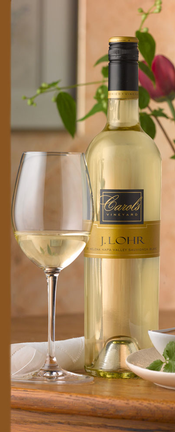J. Lohr, Napa Valley – St. Helena Sauvignon Blanc, Carol’s Vineyard 2014 ($24): Sauvignon Blanc is one of those grapes that can be successful in a wide variety of wine styles, from far-flung parts of the wine world. I appreciate all its different manifestations, and yet I have a very specific  preference for a particular style: The dry, lean, steely, compact wines with crisp acidity, herbal and mineral aromas and flavors, and concentration of fruit character. This wine is not in that style, but I admire it and enjoy it tremendously.
preference for a particular style: The dry, lean, steely, compact wines with crisp acidity, herbal and mineral aromas and flavors, and concentration of fruit character. This wine is not in that style, but I admire it and enjoy it tremendously.
J. Lohr is a winery best known for its Paso Robles vineyards and wines, particularly rich, deep reds, but the winery has vineyard properties in Napa Valley and Monterey as well. This wine is from Carol’s Vineyard, a site in the St. Helena sub-district of Napa Valley, where the winery also grows Cabernet Sauvignon.
Two decades ago, I considered Napa Valley one of my favorite terroirs for Sauvignon Blanc. Most of the wines were then being made in that dry, crisp, lean, low-key herbal style that I like and associate with some of the better white Bordeaux wines (those with minimal Semillon; the Semillon-laden wines can be fabulous, but are a different style entirely). Then gradually — perhaps with New Zealand as an influence — Napa Valley producers veered toward a more expressive style, made with riper fruit. The wines became overtly fruity, softer and, to my taste, sweeter. I still do count a handful of Napa Valley producers among my favorites for Sauvignon Blanc, but in general the wines have drifted away from my preference.
The J. Lohr 2014 Carol’s Vineyard Sauvignon Blanc is not a throwback to the wines of the 1980s and early 1990s but is a rather original Sauvignon Blanc. The wine’s salient taste characteristic is high acidity, firm and crisp, but that acidity is coupled with rich texture, somewhat oily, and lots of weight on the palate — a combination that’s unusual enough for any white wine. The aromas and flavors suggest grapefruit, green apple, lime and passionfruit, with a slightly smoky note of minerality; in your mouth, these flavors are plenty pronounced, but the wine’s strong structure of acid and rich texture draws your attention away, giving the wine a dimension beyond fruitiness and flavor. Sip after sip, this wine shows endurance and holds my interest.
After tasting this wine blind, I learned that it resulted from viticultural experimentation that J.Lohr introduced in 2013 for select Monterey and Paso Robles vineyards. “Instead of applying water on a weekly basis,” winemaking director Jeff Meier explains, “we did only two irrigations, at very specific times. By essentially mimicking natural rainfall events, we saw an intensification of the flavor of the fruit and more minerality. By 2014 it was clear to us that this irrigation method was creating a more intense, site-specific expression of our Sauvignon Blanc.” The kicker is that the winery’s water usage was reduced by 50 percent.
This wine is entirely Sauvignon Blanc, harvested in two phases one week apart and fermented mainly in stainless steel “barrels” with 16 percent of the wine in French acacia barrels. The wine aged for five months in stainless steel on its lees, with stirring. Its alcohol is moderate at 13.6 percent; its acidity stat is quite high and its pH low, as the taste of the wine suggests, and these elements render the 3.8 grams of residual sugar subliminal.
Good viticulture, good winemaking and — by the way — a good cause: Two dollars from the sale of each bottle help fund the National Breast Cancer Foundation’s efforts to provide mammograms for women in need.
90 Points
